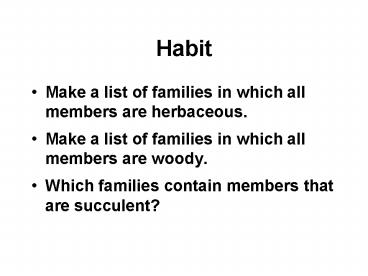Habit PowerPoint PPT Presentation
Title: Habit
1
Habit
- Make a list of families in which all members are
herbaceous. - Make a list of families in which all members are
woody. - Which families contain members that are
succulent?
2
Root and stem diversity
- Describe different types of roots and stems we
have observed this semester. - List the families where these can be found. Give
examples of economically important roots and
stems.
3
Leaf diversity (1 of 2)
- Make sure you can find the node, petiole, and
stipules (if present) associated with a leaf. - What terms are used to describe variation in the
shape, apices, bases, and margins of the lamina
and in attachment of the lamina to the shoot? - Make sure you can identify parallel vs.
reticulate venation as well as pinnate and
palmate venation. Where could you find examples
of these?
4
Leaf diversity (2 of 2)
- Make sure you know the terms to describe the
arrangement of leaves on the shoot (opposite,
alternate, etc.). Make a list of families with
opposite leaves. - Describe all of the complexity and modifications
in leaves that you can recall, and where these
were found in the plant kingdom. Examples
compound leaves, tendrils, spines, pseudobulbs,
sheathing stipules, plicate leaves.
5
Indumentum
- Describe the diversity we observed in hairs and
the families where these features can be found.
Examples stellate indumentum, hygroscopic hairs.
6
Inflorescences
- Make sure you can identify and describe or draw
all the major inflorescence types solitary
terminal and solitary axillary, spike, raceme,
panicle, simple and compound umbels, head,
dichasial and scorpioid cymes. Also special
terminology associated with inflorescences such
as spathe and spadix. Where could you find
examples of all of these?
7
Perianth
- Make lists of families with many perianth parts,
tri-merous, four-merous, and five-merous
perianths. Are there any families that lack a
perianth? What are tepals? Where would you find
an example of tepals? - What is a hypanthium and which subclass (-es)
includes families with hypanthia? - Make a list of families with sympetalous
corollas. - Make a list of families with zygomorphic flowers.
8
Androecium
- Which family (-ies) has/have stamens opposite the
petals? - Which family (-ies) has/have epipetalous stamens?
- Draw examples of mono-, and diadelphous stamens.
Where can you find these? Draw tetradynamous
stamens. Where can you find these? - What are and where can you find connivent
anthers? - Where can you find anthers that dehisce by pores?
- What are and where can you find pollinia?
- What is protandry?
9
Gynoecium (1 of 2)
- Make sure you can distinguish between pistil,
ovary, carpel, locule, ovule. - Make a list of families that consistently have
one carpel. Make lists for two, three, five, or
many carpels. - Make a list of families with syncarpous gynoecia.
- What is a stylopodium and where would you find
one? - Where would you find a forked style?
10
Gynoecium (2 of 2)
- Make a list of families with inferior ovaries.
- Make sure you can draw all the different types of
placentation (in cross section) and name the
families where the different types are found. - Where and what is the angiosperm megagametophyte?
11
Fruits
- Which families did NOT have fruits? Why not?!
- Make sure you can ID all the different fruit
types covered (including special terminology such
as accessory, aggregate, and multiple fruits).
You should be able to infer whether the ovary was
superior vs. inferior, apocarpous vs. syncarpous,
etc. from observing fruits. - Which fruit types are characteristic for a
particular family?
12
Subclasses
- Each lab (with the exception of the last) was
organized to represent the various subclasses of
angiosperms. Make a list of the families covered
in each of the subclasses, and then list the
characters that tie them together (see W K for
guidance).
13
Taxonomists Beware!
- This is a quick list of family pairs that we
think are easily confused with each other.
Perhaps you can think of others. Make a chart
comparing the distinguishing features of these
family pairs. - Cycadaceae and Arecaceae
- Piperaceae and Araceae
- Scrophulariaceae and Lamiaceae
- Cyperaceae and Poaceae
- Cupressaceae and Pinaceae
- Iridaceae and Liliaceae
14
Quick Non-Angiosperm Review(ferns and
gymnosperms) (1 of 2)
- Know the reproductive parts and where they are
located on the plant. - Be able to identify a leptosporangium and
eusporangium. - Using appropriate terminology, describe the
different types of sori. Where would you find
examples of these? Make sure can identify and
know the difference between a true indusium and
false indusium.
15
Quick Non-Angiosperm Review(ferns and
gymnosperms) (2 of 2)
- Be able to identify and use appropriate
terminology to describe the various leaf types,
and shoot types (e.g. long vs. short). - What are the differences between a cycad cone
and a pine cone? Are they bisexual or unisexual?
Are they monoecious or dioecious? - Why do gymnosperms have naked seeds? Which
angiosperm organ is missing?
16
Economics (1 of 2)
- Where appropriate, list the economically
important products derived for a particular
family. - Where appropriate, list the important cultivated
members for a particular family.
17
Economics (2 of 2)
- Try to write some questions of your own such as
- Which family (-ies) is/are an important tourist
attraction in Ithaca during autumn? - Which family (-ies) would you use to build
shelter if you lived in the tropics? Does this
differ from North America? - Which families have humans developed important
medicines from (these are usually the very
poisonous families as well!)?

